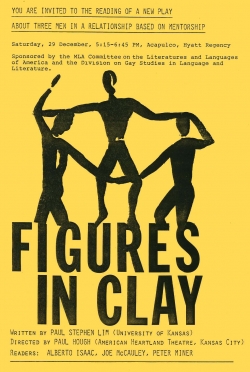Figures in Clay: A Threnody in Six Scenes and a Coda
Images from the Show
Overview
Requirements: 3M
Setting: Three chairs in Dr. Beatrice’s office. She is a marriage counselor, and the three men talk to her in different combinations–sometimes individually, sometimes in alternating groups of two, sometimes all three together–but Dr. Beatrice herself is never seen or heard. Early August, late 1980s.
Plot: Three men, twenty years apart in age, with the youngest at age 24 and the oldest at age 64, are in a problematic relationship, not least of which is that they are living in the age of A.I.D.S., and at least one of them has been sexually promiscuous.
Theme: The role that mentorship plays in relationships where a partner is considerably more senior and/or junior in age.
Notes: The lives and continuing relationships of three characters from Mother Tongue are explored further in this play. Although the text reads like a radio play, on stage the three characters shift seats between scenes, as though they are playing musical chairs. Another image I was working with is that of characters going round and round, as though on a carousel in a carnival; or like the clay figures in a shooting gallery, again in a carnival.
History: The play was given a staged reading at a special panel at the Modern Language Association (MLA) Convention on December 28, 1990 in Chicago. It was directed by Paul Hough, to whom I dedicate the play because he “believes in the art and nurtures the spirit.” The three men were played by Alberto Isaac, Peter (Miner) Matthey and Joe McCauley.
Short scene from the play: In this scene, all three men are in the office of Dr. Beatrice at the same time. They have been talking about their early sexual experiences and also their respective sexual fantasies.
ERIC: David takes great pleasure in telling the most extraordinary stories about his past.
CLARK: Only problem is, his mind embroiders. It is also quite capable of complete fabrications. Maybe that’s why he’s a writer.
ERIC: One afternoon, when we were driving across the Pasig River in Manila, he said the bridge we were on can only be experienced at four o’clock in the morning.
DAVID: Shortly after high school, I discovered a bridge in Manila which had a life of its own, but only in the pulsating hours before sunrise. At one end of the bridge was a park beyond which were all my old haunts: the bars and discos, the jazz clubs….At the other end was a large market where all the farmers and fishermen from outlying areas would bring in their goods before daybreak. To get from the bridge to the market, there was a steep stairwell, stone steps. At four o’clock one morning, after I had been drinking all night with Freddie, I found myself standing unsteadily at the top of that stairwell. I had unzipped and was about to relieve myself into the darkness when, suddenly, I heard a voice whispering softly in Tagalog. “Over here,” he said. “We are over here.” I stumbled over to the voice, and that was the beginning of an incredible journey. Perched like birds of prey on each one of the stone steps was a shadowy figure, a hungry presence. There were other, not-unwilling victims because, ahead of me, I saw them descending, receding, disappearing into blackness…and every so often one of the birds of prey would shriek with triumph: “This one is finished! I brought this one to completion!“
ERIC: Tennessee Williams would have loved that story.
DAVID: Alex Haley and the whole oral tradition notwithstanding, I find it queer how so many of my fantasies are oral in nature. Maybe I should be in oralysis, not analysis.
Availability: From Aran Press, and also from the author.


